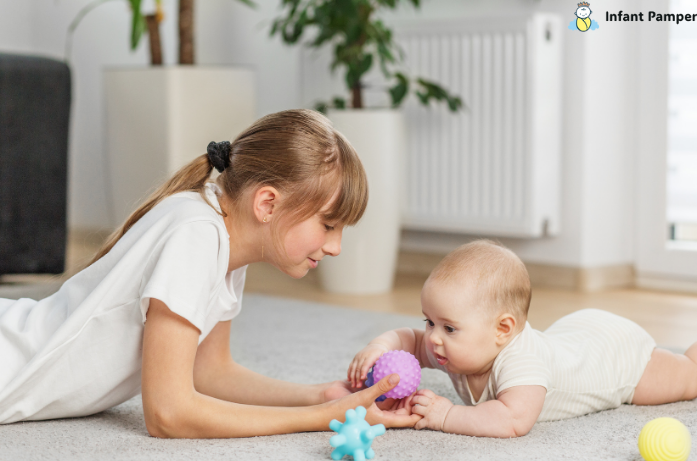By a fellow mom at Infant Pamper
When I became a mom, I thought that growth involved huge milestones, such as first steps, first words, and first birthdays. But I soon found out that the tinsy-weensy, everyday moments-meeting my baby on his tummy, holding him close in a mute cuddle, or responding to his cheerful coos-are just as critical to that growth. Those simple acts of love are developmentally sound bonding experiences.
In this article, we’ll discuss how tummy time for newborns, baby snuggles, and cooing contribute to your baby’s growth and offer ways to incorporate these newborn bonding activities into your day.
Why Every Baby Needs Tummy Time
Tummy time is placing a child on his belly while awake and being watched. According to the American Academy of Pediatrics (AAP), it’s one of the most effective ways to support gross motor skills and physical development.
- Strengthens muscles: It strengthens neck, shoulder, and arm muscles required for rolling, sitting, crawling, and walking.
- Prevents flat spots: Too much time on the back can cause flat head syndrome. Tummy time is a counter measure.
- Promotes motor skills: The efforts of lifting their head and pushing up will promote coordination and balance in later life.
According to the American Academy of Pediatrics, tummy time can be started as early as the first week, with 3 to 5 minutes per session, at least a few times a day, increasing gradually as the baby grows stronger and can stay for longer periods.

How to Make Tummy Time Fun
- Start small: Place the baby on his tummy after diaper changes or after naps.
- Use props: Newborns find it easier if a towel is rolled up and placed under his or her chest.
- Bring in toys: Nearby bright and soft toys encourage reaching and kicking.
- Get down with them: Lie down on the floor face-to-face; your presence is a great motivator.
- Sing or talk: Babies respond best to voices during those muscle-building activities.
💡 Tip: If your baby fusses during tummy time, try for shorter intervals more often. Even 1-2 minutes count.

The Power of Snuggles
If tummy time builds strong bodies, snuggles build strong hearts. Holding and cuddling your baby is far beyond comfort; it’s biology.
- Releases oxytocin: This “love hormone” reduces stress and increases bonding.
- Helps brain develop: Lastly, touch regulates emotions and supports healthy neurological development, according to studies.
- Boosts immunity and growth: Regular skin-to-skin contact stabilizes body temperature, improves sleep, and can even help with weight gain in infants. As highlighted by Stanford Children’s Health, snuggling your newborn against your skin not only feels good but also supports long-term health outcomes.
Babies being held a lot during the neonatal period end up with better vital and health outcomes in a long term, according to a study done at the University of California, San Francisco.
Snuggles shall not be limited to the first-life period of those days. Also holding babies close guarantees their sense of safe existence, whether they are 1 week or 1 year old. These small moments of closeness lay the foundation for emotional security well into childhood.
Tip: Set aside skin-to-skin time for you and baby every day. Great times include after a bath, or before bedtime. It’s nice and calming for both.
The Magic of Cooing and Early Communication
Cooing begins between the ages of 6 and 8 weeks, with those precious little vowel-like sounds of “oooo” and “ahhh” that tend to melt the hearts of parents everywhere. While it can feel like random noises, cooing is a newborn’s first step at developing language.
Why cooing matters:
- It strengthens social bonds: By responding to your baby’s noises, you’re teaching them that communication is a two-way street.
- Building vocabulary skills: Mimicking sounds, singing, or simply talking to your baby helps foster the connection in their brain between sounds and meanings.
- Encourages emotional expression: Babies feel recognized when their caregivers respond with smiles and supportive words.
According to the (NAEYC), early serve and return interactions build strong brain architecture for learning, communication, and emotional well-being.

How to Encourage Cooing
- Talk back: When your baby coos or babbles, pause and respond as if having a very short conversation.
- Sing often: Rhythmic tunes and lullabies prompt vocal responses.
- Maintain eye contact: Always hold the gaze of your baby when expressing yourself.
- Mimic sounds: Saying “ahh, ooh” back to them will encourage more vocalizing.
Tip: Don’t worry about talking “too much” to them. A baby thrives on hearing language and tone. Simply narrating your daily activities (“Mommy is making breakfast now”) is a very good exercise for early communication.
Incorporating these activities into daily life
Tummy time, snuggles, and cooing are some things that do not necessarily need extra time set aside. This is simply how you choose to live.
- After Feedings: Hold your little one upright against your chest for snuggles while chatting softly.
- Playtime: Engage your little one in time on the tummy with toys in view; sing or speak while playing.
- Bedtime: Combine cuddles with gentle songs or casual chatter about the day as a way to wind down.
- Morning routines: Start the day with 5 minutes of tummy time on a soft mat and happy chatter.
The ritualistic nature of these activities creates comfort and stability for your child while nurturing his or her physical and emotional growth.
FAQs: Parents’ Common Questions
1. What if my baby hates tummy time?
That is actually quite normal! Try shorter and more frequent sessions of 1 or 2 minutes. Use toys or mirrors to keep your baby interested. As your child grows stronger, it will become easier for him.
2. How much snuggling is “too much”?
There’s no such thing. Babies cannot be “spoiled” by physical affection. Holding them reassures and creates trust within them, and they grow with it.
3. My baby isn’t cooing yet. Should I worry?
Every baby is unique and develops at his or her own pace. Most babies coo by 8 weeks, but it could take longer for some. Keep communicating, but if you feel uneasy, discuss it with your pediatrician.
4. Could dads or caregivers engage in these activities as well?
Absolutely! It is great for all caregivers to bond with the baby through tummy time, snuggles, and talking.
5. How long should tummy time last for 3-month babies?
By 3 months, babies should be able to handle 20–30 minutes of tummy time spread throughout the day.
Final Thoughts
Parenting moments like tummy time, snuggles, and coos are precious because they serve as core experiences for the growth and development of a child. These perform functions strengthening the building of physical strength, emotional security, and early expressions of communication that last a lifetime.
They are not just “trivial” matters. And, they form the basis for the development of your infant and will also serve as cherished memories in which you will forever indulge.
Therefore, the next time you find yourself sitting on the floor encouraging your infant during tummy time, holding him or her close after feeding, or mimicking agreeable coos, know that you are not merely bonding, fair talents shore-way to assure that your baby grows in full.
Disclamer: This article is for informational purposes only and should not replace medical advice. Always check with your pediatrician if you have concerns about your baby’s growth or development.
At Infant Pamper, we believe parenthood is made of these beautiful little moments. If you enjoyed this guide, explore more parenting tips, insights, and heartwarming advice on Infant Pamper.




